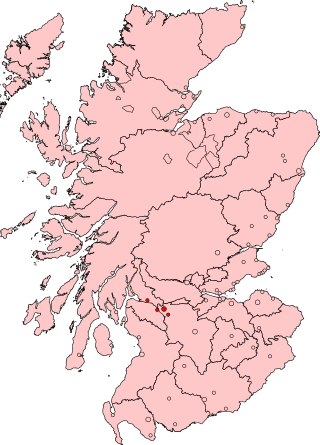Related Research Articles

North-East Fife was one of three local government districts in the Fife region of Scotland from 1975 - 1996.
Elgin Burghs was a district of burghs constituency of the House of Commons of Great Britain from 1708 to 1801 and of the House of Commons of the United Kingdom from 1801 to 1918. Until 1832, when Peterhead was added, the constituency comprised the parliamentary burghs of Elgin, Cullen, Banff, Inverurie and Kintore, lying in Elginshire, Banffshire and Aberdeenshire.
Aberdeenshire was a Scottish county constituency of the House of Commons of the Parliament of Great Britain from 1708 to 1800 and of the House of Commons of the Parliament of the United Kingdom from 1801 until 1868.
Dumfries Burghs was a district of burghs constituency of the House of Commons of Great Britain from 1708 to 1801 and of the House of Commons of the Parliament of the United Kingdom from 1801 until 1918. It elected one Member of Parliament (MP).
Haddington Burghs was a Scottish district of burghs constituency of the House of Commons of Great Britain from 1708 to 1801 and of the House of Commons of the United Kingdom from 1801 until 1885. It elected one Member of Parliament (MP) using the first-past-the-post voting system.
East Fife was a county constituency represented in the House of Commons of the Parliament of the United Kingdom from 1885 to 1983. Along with West Fife, it was formed by splitting the old Fife constituency.
Inverness Burghs was a district of burghs constituency of the House of Commons of the Parliament of Great Britain from 1708 to 1801 and of the Parliament of the United Kingdom from 1801 to 1918. It elected one Member of Parliament (MP).
Stirling Burghs was a district of burghs constituency of the House of Commons of the Parliament of the United Kingdom from 1708 to 1918.
St Andrews Burghs was a district of burghs constituency, representing various burghs of Fife, Scotland, in the House of Commons of the Parliament of the United Kingdom, from 1832 to 1918.
Wigtown Burghs, also known as Wigton Burghs,. was a constituency of the House of Commons of the Parliament of Great Britain from 1708 to 1800 and of the House of Commons of the Parliament of the United Kingdom from 1801 to 1885. It was represented by one Member of Parliament (MP).
Aberdeen Burghs was a district of burghs constituency which was represented from 1708 to 1800 in the House of Commons of the Parliament of Great Britain, and from 1801 to 1832 in the House of Commons of the Parliament of the United Kingdom.

Perth Burghs was a district of burghs constituency of the House of Commons of the Parliament of Great Britain from 1708 to 1801 and of the Parliament of the United Kingdom from 1801 until 1832, representing a seat for one Member of Parliament (MP)

Clyde Burghs, also known as Glasgow Burghs, was a district of burghs constituency of the House of Commons of Great Britain from 1708 to 1801 and of the House of Commons of the United Kingdom from 1801 to 1832. It elected one Member of Parliament (MP).
Renfrewshire was a county constituency of the House of Commons of the Parliament of Great Britain from 1708 until 1801 and of the Parliament of the United Kingdom from 1801 to 1885.
Lanark Burghs was a district of burghs constituency of the House of Commons of the Parliament of the United Kingdom from 1708 to 1832, representing a seat for one Member of Parliament (MP).
Crail in Fife was a royal burgh that returned one commissioner to the Parliament of Scotland and to the Convention of Estates.
Anstruther Easter in Fife was a royal burgh, created in 1583, that returned one commissioner to the Parliament of Scotland and to the Convention of Estates.
Anstruther Wester in Fife was a royal burgh, created in 1587, that returned one commissioner to the Parliament of Scotland and to the Convention of Estates.
Kilrenny in Fife was a royal burgh that returned one commissioner to the Parliament of Scotland and to the Convention of Estates.
Pittenweem in Fife was a royal burgh that returned one commissioner to the Parliament of Scotland and to the Convention of Estates.
References
- ↑ "Anstruther Burghs". History of Parliament Online (1690-1715). Retrieved 27 March 2019.
- ↑ "Anstruther Burghs". History of Parliament Online (1715-1754). Retrieved 27 March 2019.
- ↑ "Anstruther Burghs". History of Parliament Online (1754-1790). Retrieved 27 March 2019.
- ↑ "Anstruther Burghs". History of Parliament Online (1790-1820). Retrieved 27 March 2019.
- 1 2 3 "Anstruther Burghs". History of Parliament Online (1820-1832). Retrieved 27 March 2019.
- ↑ Stooks Smith, Henry. (1973) [1844–1850]. Craig, F. W. S. (ed.). The Parliaments of England (2nd ed.). Chichester: Parliamentary Research Services. pp. 628–629. ISBN 0-900178-13-2.
- ↑ Fisher, David R. "BALFOUR, James (c.1775-1845), of Whittinghame, Haddington; Balgonie, Fife, and 3 Grosvenor Square, Mdx". The History of Parliament. Retrieved 25 May 2020.
- ↑ Fisher, David R. "JOHNSTON, Andrew (1798-1862), of Rennyhill, Fife". The History of Parliament. Retrieved 25 May 2020.
- 1 2 Cook, Chris; Stevenson, John (1980). British Historical Facts 1760-1830. Basingstoke: Palgrave. p. 58. doi:10.1007/978-1-137-06465-3. ISBN 978-1-137-06465-3 . Retrieved 7 May 2020– via Google Books.